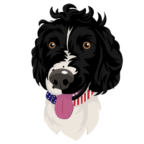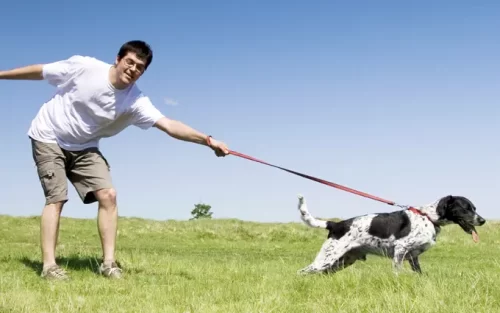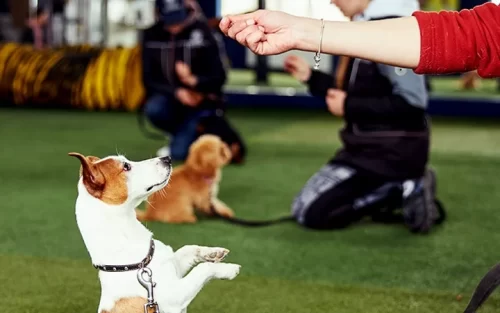Socializing your dog is a crucial part of their upbringing and development, ensuring they become well-adjusted, confident, and happy members of your family. A well-socialized dog is less likely to be fearful, anxious, or aggressive. This makes it easier for them to navigate various situations and environments throughout their life. So let’s answer your question, “How do I socialize my dog?”
In this comprehensive guide, we’ll explore the importance of socialization, the steps involved, and how you can create a successful socialization plan for your furry friend.
The socialization process is all about exposing your dog to new experiences, people, animals, and environments in a positive and controlled manner. This helps them learn how to cope with new situations and understand that the world is a safe and enjoyable place.
When done correctly, socialization can lead to a lifetime of benefits. This will include a stronger bond between you and your dog, reduced likelihood of behavior issues, and an increased ability to adapt to change.
One of the key aspects of successful socialization is understanding the critical socialization period. This is the time when your dog is most receptive to new experiences and when their brain is rapidly developing. For puppies, this period typically occurs between 3 and 14 weeks of age, making it the ideal time to start the process. However, don’t worry if you’ve adopted an adult dog or missed this window. While the process may be a bit different, it’s never too late to start socializing your dog.
Creating a socialization plan involves setting clear goals and objectives, identifying opportunities for exposure to new experiences. It also involves using gradual, positive reinforcement to help your dog build confidence and trust. This plan will guide you in introducing your dog to a variety of people, other dogs, animals, and environments, helping them become well-rounded and adaptable. Remember that every dog is unique, so it’s essential to tailor your approach to your dog’s needs and comfort level.
Throughout this guide, we’ll explore various aspects of socialization. This will include introducing your dog to different types of people, fostering positive interactions with other dogs and animals, and exposing them to a range of environments and situations. We’ll also discuss the importance of handling and grooming in the socialization process, as well as the role of training and behavior modification in addressing any challenges that may arise.
Lastly, we’ll emphasize the importance of maintaining and refining your dog’s social skills throughout their life. As your dog grows and changes, so will their socialization needs. Being proactive and attentive to their experiences will ensure they continue to thrive and enjoy life to the fullest.
So, whether you’re a new dog owner or a seasoned pet parent looking to brush up on your knowledge, this guide is designed to help you navigate the world of dog socialization with confidence. By investing time and effort into this essential aspect of your dog’s development, you’ll be setting them up for a lifetime of happiness, companionship, and adventure. Let’s dive in and get started on this exciting journey!
- The Socialization Period
- Creating a Socialization Plan
- How Do I Socialize My Dog With People?
- Socialization with Other Dogs
- How Do I Socialize My Dog With Other Animals?
- Exposure to Various Environments and Situations
- Handling and Grooming
- How Do I Socialize My Dog Through Training and Behavior Modification?
- Maintaining Social Skills
- Socializing Different Breeds
- How Do I Socialize My Dog? Our Conclusion
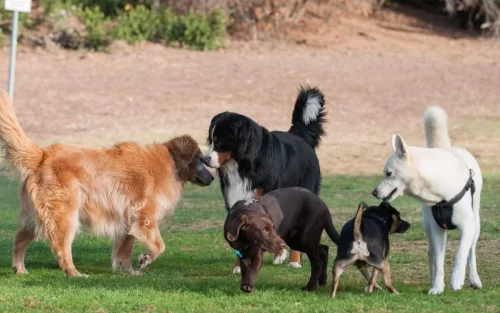
The Socialization Period
The Socialization Period is a crucial stage in your dog’s development and plays a significant role in shaping their personality, behavior, and ability to adapt to new situations. Understanding this period is essential to ensure you’re providing your dog with the best possible start in life.
For puppies, the critical socialization period typically occurs between 3 and 14 weeks of age. During this time, their brains are rapidly developing, and they are most receptive to new experiences. It’s within this window that puppies form associations and learn how to respond to various stimuli in their environment. By exposing them to a wide range of positive experiences during this period, you can help them develop into well-adjusted, confident, and friendly adult dogs.
While the critical socialization period is most crucial for puppies, it’s essential to note that adult dogs can still benefit from socialization efforts. If you’ve adopted an older dog or missed the early socialization window, don’t worry! Adult dogs can still learn new behaviors and adapt to different situations; however, the process might be more gradual and require additional patience and understanding.
During the socialization period, it’s vital to expose your dog to various people, animals, environments, and situations while ensuring that these experiences are positive and controlled. Remember to consider your dog’s individual needs and comfort levels, and avoid overwhelming them with too much too soon.
In summary, the socialization period is a critical stage in your dog’s development, with long-lasting effects on their behavior and adaptability. By understanding this period and providing your dog with a range of positive experiences, you can set them up for success as they grow and mature. Keep in mind that the socialization process is an ongoing journey, and it’s essential to continue reinforcing and building upon these experiences throughout your dog’s life.
Creating a Socialization Plan
Creating a socialization plan is an essential step in ensuring your dog receives the right exposure to new experiences, people, animals, and environments. A well-structured plan helps you stay organized and focused on your goals, while also ensuring that your dog’s socialization experience is positive and effective. Here are some key elements to consider when developing a socialization plan for your furry companion:
- Set clear goals and objectives: Determine what you want your dog to achieve through the socialization process, and identify specific areas where they may need extra attention. For instance, you may want your dog to feel comfortable around children or be able to calmly walk through a crowded park.
- Identify opportunities for exposure: List various situations, environments, and individuals that your dog should be exposed to during the socialization process. This may include meeting people of different ages, genders, and appearances, as well as encountering other dogs, cats, and various animals. Consider different environments such as busy streets, parks, and pet-friendly stores.
- Prioritize positive reinforcement: Use praise, treats, and affection to reward your dog for appropriate behavior during socialization encounters. This positive reinforcement will help your dog associate new experiences with positive outcomes, building their confidence and trust.
- Gradual exposure: Introduce new experiences at a pace that is comfortable for your dog, gradually increasing the complexity and duration of encounters as they become more confident. Avoid overwhelming your dog by introducing too much too soon.
- Monitor and adjust: Regularly assess your dog’s progress and adjust your socialization plan as needed. If your dog shows signs of stress or fear, take a step back and reassess your approach, making necessary modifications to ensure a positive experience.
- Involve the whole family: Encourage all family members to participate in the socialization process, as it helps your dog become comfortable with various people and strengthens the bond between your dog and your family.
By creating and following a well-structured socialization plan, you’ll be better equipped to expose your dog to a wide range of positive experiences, helping them become well-adjusted, confident, and adaptable members of your family. Remember, socialization is an ongoing process, so continue to reinforce and build upon these experiences throughout your dog’s life.
How Do I Socialize My Dog With People?
Socialization with people is an essential aspect of your dog’s development, helping them learn to interact positively and confidently with various individuals. Ensuring that your dog is comfortable and well-behaved around people can make life more enjoyable for both you and your furry companion. Here are some tips for effectively socializing your dog with people:
- Start early: Begin socializing your dog with people as early as possible, ideally during the critical socialization period. However, if you’ve adopted an older dog, don’t worry – it’s never too late to start the process!
- Diverse interactions: Expose your dog to people of different ages, genders, ethnicities, and appearances. This variety helps your dog become comfortable with all types of individuals and minimizes the likelihood of them developing fear or anxiety toward specific groups.
- Teach good manners: Encourage polite behavior by teaching your dog not to jump on people, to greet calmly, and to sit when meeting new individuals. Reward your dog with treats and praise when they demonstrate appropriate behavior.
- Encourage positive associations: Make sure your dog’s encounters with people are enjoyable and positive. Ask friends and family members to interact with your dog calmly and gently, offering treats or toys to create a positive association with meeting new people.
- Take it slow: Be patient and considerate of your dog’s comfort level during socialization encounters. If your dog appears nervous or stressed, give them space and time to adjust. Gradually increase the intensity and duration of interactions as your dog becomes more comfortable.
- Involve children: Introducing your dog to children is particularly important, as they can sometimes be unpredictable and have different behaviors than adults. Teach children how to interact respectfully with your dog, and always supervise their interactions to ensure both parties are safe and comfortable.
- Join training classes or socialization groups: Participating in dog training classes or socialization groups can provide valuable opportunities for your dog to meet and interact with various people in a controlled and structured environment.
By focusing on socialization with people, you’ll help your dog develop confidence and trust in humans, making everyday interactions more enjoyable and stress-free for both you and your pet. Remember to be patient and consistent, and to celebrate your dog’s progress along the way!
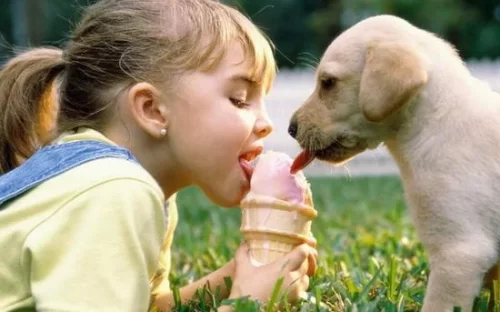
Socialization with Other Dogs
Socializing your dog with other dogs is crucial for their overall well-being, helping them learn essential canine communication skills and enjoy healthy, positive interactions with their fellow four-legged friends. Here are some tips for effectively socializing your dog with other dogs:
- Start early: The best time to begin socializing your dog with other dogs is during the critical socialization period, between 3 and 14 weeks of age. However, older dogs can also benefit from socialization, so don’t hesitate to start if you’ve adopted an adult dog.
- Use positive reinforcement: Reward your dog with treats, praise, or affection when they display appropriate behavior during interactions with other dogs. This positive reinforcement encourages good manners and helps your dog associate socializing with positive experiences.
- Gradual exposure: Introduce your dog to other dogs slowly and carefully, beginning with one-on-one playdates or controlled group settings such as puppy classes or dog parks with separate areas for small and large dogs. Gradually increase the size and diversity of the group as your dog becomes more comfortable.
- Choose suitable playmates: Look for dogs with compatible play styles and energy levels, as this can make interactions more enjoyable and less stressful for your dog. Be mindful of size differences, as larger dogs can sometimes inadvertently injure smaller playmates during rough play.
- Monitor body language: Keep a close eye on your dog’s body language during interactions with other dogs, and intervene if you notice signs of stress, fear, or aggression. Learning to read canine body language can help you prevent negative encounters and ensure a positive socialization experience for your dog.
- Teach good manners: Encourage your dog to play politely with other dogs by discouraging behaviors such as mounting, excessive barking, or rough play. Teaching your dog basic commands such as “sit,” “stay,” and “leave it” can also be helpful in managing their behavior during social interactions.
- Attend dog training classes or socialization groups: Enrolling in a dog training class or joining a socialization group provides a structured environment for your dog to meet and interact with other dogs under the guidance of a professional trainer. This can be particularly beneficial for dogs that are shy, fearful, or have had limited exposure to other dogs.
By dedicating time and effort to socializing your dog with other dogs, you’ll help them develop essential social skills and enjoy more fulfilling, positive interactions with their canine companions. Remember, socialization is an ongoing process, so continue to provide opportunities for your dog to interact with others throughout their life.
How Do I Socialize My Dog With Other Animals?
Socializing your dog with other animals is important, particularly if you live in an area with diverse wildlife or have other pets at home. Proper socialization helps your dog learn how to interact safely and respectfully with various species, reducing the risk of conflict or injury. Here are some tips for effectively socializing your dog with other animals:
- Begin early: As with any socialization, it’s best to start when your dog is young, ideally during the critical socialization period. However, older dogs can still benefit from exposure to other animals, so don’t hesitate to start if you’ve adopted an adult dog.
- Gradual exposure: Introduce your dog to different types of animals slowly and carefully, beginning with controlled, supervised encounters. Keep your dog on a leash to ensure safety and control, and gradually increase the level of interaction as your dog becomes more comfortable.
- Create positive associations: Encourage your dog to associate meeting other animals with positive experiences by rewarding them with treats, praise, or affection during encounters. This helps to build confidence and trust in their interactions with various species.
- Monitor body language: Keep a close eye on your dog’s body language during interactions with other animals, and intervene if you notice signs of stress, fear, or aggression. Learning to read your dog’s body language is essential for preventing negative encounters and ensuring a positive socialization experience.
- Respect the other animal’s boundaries: Be mindful of the other animal’s comfort level and personal space. Some animals, such as cats or small pets, may be more easily stressed or frightened by a dog’s presence, so it’s essential to be patient and considerate during introductions.
- Teach impulse control: Training your dog to respond to basic commands like “sit,” “stay,” and “leave it” can be invaluable when socializing them with other animals. This helps to prevent chasing, rough play, or other unwanted behaviors during encounters.
- Involve professional help if needed: If your dog struggles with socializing with other animals, consider consulting a professional dog trainer or behaviorist. They can provide personalized guidance and support to help your dog develop appropriate social skills and overcome any fears or anxieties.
By taking the time to socialize your dog with various types of animals, you’ll help them develop the skills and confidence needed to navigate a diverse range of encounters safely and respectfully. Remember that socialization is an ongoing process, and regular exposure to different animals will ensure your dog remains comfortable and well-adjusted throughout their life.
Exposure to Various Environments and Situations
Exposing your dog to a variety of environments and situations is crucial for building their confidence, adaptability, and overall well-being. A well-socialized dog is more likely to remain calm and composed in different settings, making them easier to manage and more enjoyable to be around. Here are some tips for introducing your dog to various environments and situations:
- Start early: As with all socialization, it’s best to begin exposing your dog to new environments and situations during the critical socialization period. However, adult dogs can still benefit from these experiences, so don’t hesitate to start if you’ve adopted an older dog.
- Gradual exposure: Introduce your dog to new environments and situations gradually, allowing them time to explore and acclimate at their own pace. Avoid overwhelming your dog by initially limiting the level of stimulation, and gradually increase the complexity and intensity of the experiences as they become more comfortable.
- Create positive associations: Help your dog associate new environments and situations with positive experiences by rewarding them with treats, praise, or affection during exposure. This positive reinforcement encourages confidence and trust, making it easier for your dog to adapt to new experiences.
- Diversify experiences: Expose your dog to a wide range of environments and situations, such as busy streets, parks, elevators, car rides, and outdoor cafes. Include various surfaces, sounds, and smells to help your dog become comfortable with an array of sensory experiences.
- Socialize in different weather conditions: Introduce your dog to various weather conditions, such as rain, snow, and heat. This helps your dog learn how to cope with different temperatures and weather-related challenges, ensuring their comfort and safety.
- Practice good manners: Encourage your dog to display appropriate behavior in different environments and situations by reinforcing basic obedience commands, such as “sit,” “stay,” and “come.” This helps to establish boundaries and expectations, making your dog more manageable and well-behaved in various settings.
- Monitor your dog’s stress levels: Keep an eye on your dog’s body language during exposure to new environments and situations, and intervene if you notice signs of stress, fear, or anxiety. Be patient and supportive, and allow your dog to progress at their own pace.
By consistently exposing your dog to various environments and situations, you’ll help them develop the confidence, adaptability, and resilience needed to navigate the world with ease. Remember that socialization is an ongoing process, and continuing to introduce your dog to new experiences throughout their life will ensure they remain well-adjusted and content.
Handling and Grooming
Introducing your dog to handling and grooming from an early age is essential for their overall health, well-being, and comfort. A dog that is comfortable with being touched and groomed will be easier to manage during routine care and veterinary visits. Here are some tips for effectively socializing your dog to handling and grooming:
- Start early: Begin handling and grooming your dog during their critical socialization period. However, if you’ve adopted an adult dog, it’s still important to work on this aspect of socialization to make grooming and care easier for both you and your dog.
- Gradual exposure: Introduce your dog to handling and grooming gradually, starting with brief, gentle touches and progressing to more involved grooming tasks, such as brushing, nail trimming, and ear cleaning. Allow your dog to become comfortable with each step before moving on to the next.
- Create positive associations: Help your dog associate handling and grooming with positive experiences by rewarding them with treats, praise, or affection during these activities. This positive reinforcement helps to build trust and ensures your dog remains relaxed and comfortable.
- Be gentle and patient: Approach handling and grooming with a calm, gentle demeanor to help your dog feel at ease. Be patient and understanding, especially if your dog is nervous or unsure about being touched.
- Use the right tools: Invest in high-quality grooming tools designed specifically for your dog’s coat type and needs. Using the appropriate tools ensures a more comfortable and effective grooming experience for your dog.
- Practice handling various body parts: Make sure to handle all parts of your dog’s body, including their ears, paws, tail, and mouth. This helps to desensitize them to being touched in these sensitive areas, making it easier for you and your veterinarian to examine and care for your dog.
- Make grooming a routine: Establish a regular grooming routine to help your dog become familiar with the process and develop a positive association with handling and care. This routine not only helps to maintain your dog’s coat, skin, and overall health but also serves as an opportunity to bond with your pet.
By consistently working on handling and grooming socialization, you’ll help your dog become more comfortable with routine care, making these tasks less stressful and more enjoyable for both you and your dog. Remember that socialization is an ongoing process, and continuing to reinforce positive experiences with handling and grooming will ensure your dog remains well-adjusted and content.
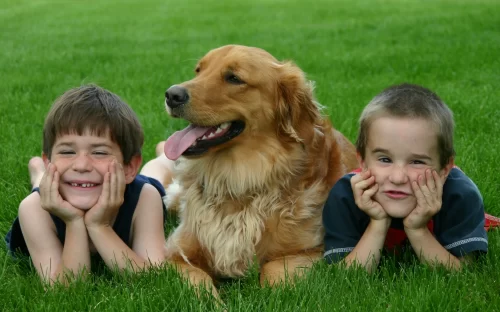
How Do I Socialize My Dog Through Training and Behavior Modification?
Training and behavior modification are essential aspects of socializing your dog, helping them become well-mannered, obedient, and adaptable companions. A well-trained dog is not only easier to manage in various situations but also more enjoyable to be around. Here are some tips for incorporating training and behavior modification into your dog’s socialization process:
- Start early: Begin training and behavior modification during your dog’s critical socialization period. However, don’t hesitate to work on these aspects with older dogs, as they can still benefit from consistent training and guidance.
- Use positive reinforcement: Focus on positive reinforcement techniques, such as rewarding your dog with treats, praise, or affection when they display desired behaviors. This approach not only helps to build trust but also encourages your dog to repeat these behaviors in the future.
- Consistency is key: Be consistent with your training methods and expectations, ensuring that all family members and caregivers are on the same page. This consistency helps your dog understand what is expected of them and prevents confusion.
- Set realistic goals: Establish realistic training goals for your dog, taking into consideration their age, breed, and individual abilities. Break down complex tasks into smaller, manageable steps, and be patient as your dog learns and progresses.
- Socialize during training: Incorporate socialization experiences into your training sessions by practicing obedience commands and behavior modification techniques in various environments and situations. This helps your dog generalize their learning and become more adaptable.
- Address unwanted behaviors: If your dog displays unwanted behaviors, such as aggression, fear, or anxiety, seek professional guidance from a qualified dog trainer or behaviorist. They can help you develop a customized behavior modification plan to address these issues and ensure your dog’s well-being.
- Make training fun and engaging: Keep training sessions fun, engaging, and positive for your dog. This not only helps to maintain their interest and motivation but also strengthens the bond between you and your pet.
- Practice patience and persistence: Remember that training and behavior modification take time and persistence. Be patient with your dog’s progress and celebrate their achievements, no matter how small.
By consistently focusing on training and behavior modification, you’ll help your dog develop the skills and confidence needed to navigate the world with ease. Remember that socialization is an ongoing process, and continuing to reinforce positive behaviors and experiences will ensure your dog remains well-adjusted and content throughout their life.
Maintaining Social Skills
Maintaining your dog’s social skills is crucial for their overall well-being and happiness. A well-socialized dog is more likely to be confident, adaptable, and well-behaved in various situations. Here are some tips for ensuring your dog’s social skills remain sharp and well-developed:
- Regular exposure: Continue to expose your dog to various people, animals, environments, and situations throughout their life. This ongoing exposure helps to reinforce their socialization experiences and ensures they remain comfortable in different settings.
- Dog-friendly activities: Participate in dog-friendly activities, such as group obedience classes, dog park visits, or organized dog walks. These events provide opportunities for your dog to interact with other dogs and people, further developing their social skills.
- Encourage appropriate play: Teach your dog appropriate play behaviors and regularly engage in playtime with them. Playing with your dog not only strengthens your bond but also helps them practice their social skills and burn off energy.
- Monitor behavior: Keep an eye on your dog’s behavior during social interactions. If you notice any signs of fear, aggression, or anxiety, intervene and address these issues promptly to prevent them from escalating.
- Reinforce good behavior: Praise and reward your dog for displaying appropriate social behaviors, such as calmly greeting new people or animals. Positive reinforcement helps to reinforce these behaviors and ensures your dog continues to exhibit them in the future.
- Continue training and obedience: Maintain your dog’s training and obedience skills by practicing commands and behavior modification techniques regularly. A well-trained dog is more likely to be well-behaved and adaptable in various social situations.
- Seek professional guidance: If your dog exhibits unwanted behaviors or seems to struggle with socialization, consult a professional dog trainer or behaviorist for guidance. They can help you develop a tailored plan to address your dog’s specific needs and improve their social skills.
- Adapt to your dog’s needs: As your dog ages, their socialization needs may change. Be mindful of these changes and adjust your approach accordingly, ensuring that your dog remains comfortable and confident in various situations.
By consistently focusing on maintaining and reinforcing your dog’s social skills, you’ll help them remain well-adjusted, confident, and happy throughout their life. Remember that socialization is an ongoing process, and your dog’s social skills will continue to evolve and develop as they experience new situations and environments.
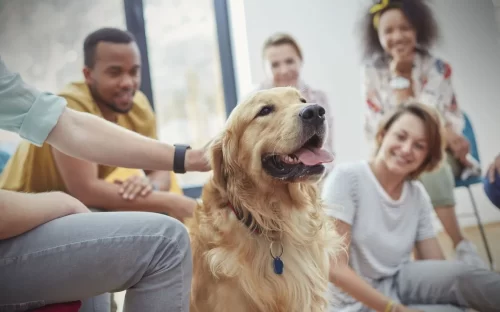
Socializing Different Breeds
Socializing dogs can vary in complexity depending on the breed. Some breeds may face unique challenges during the socialization process, while others may be naturally more sociable. In this section, we will explore some examples of breeds with specific socialization challenges and those that are generally easier to socialize.
Challenging Breeds to Socialize
- Chow Chow: Chow Chows are known for their aloof and independent nature, which can make socialization more difficult. They tend to be reserved around strangers and may be protective of their family. It’s essential to start socializing Chow Chows early and consistently expose them to various situations to help them develop a well-rounded temperament.
- Akita: Akitas are a dominant and strong-willed breed, often wary of strangers and other dogs. Early, consistent socialization is crucial for Akitas to prevent potential aggression and ensure they become well-adjusted adults. Introducing them to a variety of people, animals, and environments from a young age is essential.
- Shar-Pei: This breed is known for its loyalty to its family, which can sometimes translate into wariness or aggression towards strangers and other animals. Consistent socialization is necessary for Shar-Peis to help them develop a more accepting and friendly demeanor.
- Dachshund: Dachshunds can be stubborn and possessive, which may lead to aggression towards other dogs or people. It’s crucial to socialize Dachshunds early and work on obedience training to help them become more adaptable and friendly with others.
- Shiba Inu: This breed is known for its independence and aloofness, which can make socialization challenging. Shiba Inus need early, consistent exposure to various situations to help them develop a more balanced temperament.
Naturally Social Breeds
- Golden Retriever: Golden Retrievers are known for their friendly and sociable nature, making them relatively easy to socialize. They usually get along well with people, other dogs, and even other animals. Nonetheless, it’s essential to continue socializing them throughout their life to maintain their well-adjusted temperament.
- Labrador Retriever: Labradors are another breed that is generally easy to socialize, thanks to their outgoing and friendly disposition. They typically enjoy meeting new people and animals and adapt well to different environments. As with any breed, continued socialization is crucial to ensure a well-rounded adult dog.
- Beagle: Beagles are a sociable and curious breed that generally enjoy interacting with people and other animals. Early socialization is still necessary for Beagles to ensure they develop a well-adjusted temperament and to curb any potential issues, such as excessive barking or anxiety.
- English Springer Spaniel: This breed is known for its affectionate and friendly nature, making them relatively easy to socialize. They generally enjoy meeting new people and animals and are adaptable to various environments. Regular socialization is essential to maintain their friendly demeanor and prevent any potential issues, such as separation anxiety.
- Poodle: Poodles are intelligent and friendly dogs that are usually easy to socialize. They tend to get along well with people and other animals, making them adaptable to various situations. Consistent socialization is still necessary to ensure they remain well-adjusted and sociable throughout their life.
It’s essential to consider the specific challenges and advantages of your dog’s breed when planning their socialization. Regardless of breed, early and consistent socialization is vital for all dogs to help them develop a well-rounded temperament and become confident, adaptable companions. Always adjust your approach to suit your dog’s individual needs and work with a professional trainer or behaviorist if you encounter any difficulties during the socialization process.
How Do I Socialize My Dog? Our Conclusion
Socializing your dog is a vital part of their development, helping them grow into well-adjusted, confident, and adaptable companions. It’s essential to start the socialization process as early as possible and create a comprehensive plan that exposes your dog to various people, animals, environments, and situations. Regular handling and grooming will help your dog become more comfortable with being touched, while obedience training and behavior modification can address any issues that may arise during the socialization process.
Keep in mind that some breeds may have specific challenges or advantages when it comes to socialization, and it’s crucial to tailor your approach to your dog’s individual needs. Regardless of your dog’s breed, consistent and positive exposure to new experiences will help them become more confident and accepting of the world around them.
Socialization is an ongoing process, so continue to expose your dog to new experiences throughout their life to maintain their social skills and ensure they remain adaptable and well-rounded companions. By investing time and effort into your dog’s socialization, you’ll be rewarded with a happy, confident, and well-behaved best friend.
